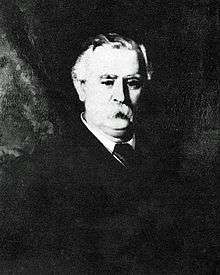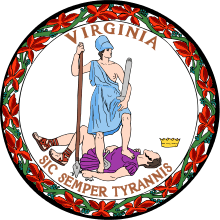Philip W. McKinney
| Philip Watkins McKinney | |
|---|---|
 Portrait of Governor McKinney | |
| 41st Governor of Virginia | |
|
In office January 1, 1890 – January 1, 1894 | |
| Lieutenant | James Hoge Tyler |
| Preceded by | Fitzhugh Lee |
| Succeeded by | Charles Triplett O'Ferrall |
| Member of the Virginia House of Delegates | |
|
In office 1858 | |
| Personal details | |
| Born |
March 17, 1832 Buckingham County, Virginia |
| Died |
March 1, 1899 (aged 66) Farmville, Virginia |
| Political party | Democratic |
| Spouse(s) | Ann Fleming Christian; Annie Clay |
| Alma mater | Hampden–Sydney College, Washington College |
| Profession | Politician, lawyer, soldier |
Philip Watkins McKinney (March 17, 1832 – March 1, 1899) was an Virginia lawyer, soldier and politician. McKinney served in the Virginia House of Delegates, was the Commonwealth attorney for Prince Edward County, and was elected as the 41st Governor of Virginia, serving from 1890 to 1894.
Early life
Born in New Store, in Buckingham County, Virginia, Philip McKinney was the son of Charles and Martha McKinney.[1] His undergraduate education was at Hampden–Sydney College, where he graduated with honors in 1851.[2] McKinney then studied law at Washington College under John White Brockenbrough.[1] After graduating, he started the practice of law and was married twice, first to Ann Fleming Christian and then to Annie Clay, with each marriage producing one child.[2][3]
War and politics
In 1858, McKinney was elected to the Virginia House of Delegates, representing Buckingham County.[2] However, at the outbreak of the Civil War, he joined the Confederate army as an officer in Company K of the 4th Virginia Cavalry. He sustained a serious injury in 1863 at the Battle of Brandy Station, thus ending his fighting career.[1]
After the war, McKinney started a law practice in Farmville, but soon returned to politics. He served multiple terms as the Commonwealth Attorney for Prince Edward County throughout the next twenty years.[1] However, he also lost a number of electoral campaigns during that time, including for U.S. Congress, Virginia Attorney General and Governor.[3]
McKinney ran for Governor for the second time in 1889, this time soundly beating Republican William Mahone, with McKinney winning 57.19% of the vote. The central theme of McKinney's gubernatorial campaign was white supremacy and the danger of African-American advancement.[4] Once elected, his primary focus as Governor was on developing the state economy and increasing the power of the Virginia Democratic party.[3]
After leaving office, McKinney retired to private life, settling with his wife in Farmville, Virginia. He died there in 1899 and was interred at Farmville Cemetery.[1] His Queen-Anne-style house still stands in Farmville.
References
- 1 2 3 4 5 "A Guide to the Executive papers of Governor Phillip W. McKinney, 1889-1893 (bulk 1890-1893)". the Library of Virginia. Retrieved 11 August 2015.
- 1 2 3 Robert Alonzo Brock; Virgil Anson Lewis (1888). Virginia and Virginians: Eminent Virginians ... History of Virginia from Settlement of Jamestown to Close of the Civil War, Volume 2. H.H. Hardesty. p. 628. ISBN 1142630730.
- 1 2 3 "Virginia Governor Philip Watkins McKinney". National Governors Association. Retrieved 12 August 2015.
- ↑ Ronald L. Heinemann [et al] (2008). Old Dominion, New Commonwealth : a History of Virginia, 1607-2007. Charlottesville: University of Virginia Press. p. 268. ISBN 0813927692.
External links
- A Guide to the Executive papers of Governor Phillip W. McKinney, 1889-1893 (bulk 1890-1893) at The Library of Virginia
- National Governors Association biography
| Political offices | ||
|---|---|---|
| Preceded by Fitzhugh Lee |
Governor of Virginia 1890–1894 |
Succeeded by Charles Triplett O'Ferrall |
